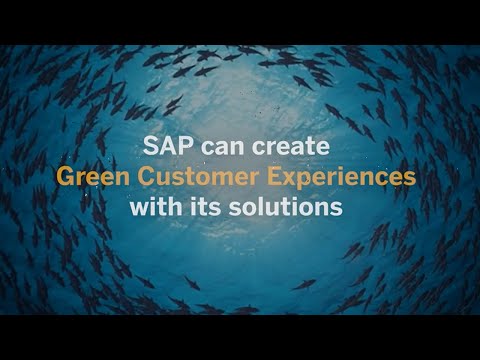Customers’ purchasing decisions are powering the future of enterprise sustainability. Many organizations are implementing technology to connect commerce, marketing, sales, and service data in order to create engaging customer experiences (CX).
Connecting demand – supply chain – and delivery is the first step, but evolving a great customer experience takes it a step further and puts sustainability front and center.
Market and investor pressure, business impact, and customer pressure are shaping the demand for sustainable business practices.
Indeed, nearly half (49%) of investors globally would divest from companies that are not taking sufficient action on environmental, social, and governance (ESG) issues. And a corporate market trend shows 73% of all B2B buyers plan to deselect suppliers based on environmental performance.
Meanwhile, customers have more choice than ever. A recent Accenture Strategy study of 25,000 global consumers found that, of customers who switched companies in the past year, 46% did so because they lost trust in the company. Today’s consumer is choosing green; the B2C marketplace is experiencing 7x growth on sustainably marketed products.
Market leaders understand the evolution from an intelligent enterprise to a sustainable one. They’re addressing the vital integration between the B2C front office and the backend B2B landscape to deliver on the growing green demand from employees, consumers, investors, and governments alike.

Enter SAP’s focus on sustainable, green customer experiences, customer-centric green experiences built on trusted data to increase customer loyalty, facilitate eco-conscious behaviors, and promote sustainable consumption. SAP’s focus on green customer experiences supports businesses with climate transparency, waste reduction, and circular practices – all while prompting long-term behavioral change.
We know that forward-thinking businesses are eager to respond to customers’ appetite for sustainability. According to a study conducted by Oxford Economics and SAP, 74% of digital transformation leaders said they’ve seen an increase in customer loyalty, 70% have seen an increase in new revenue streams, and 59% have seen a reduction in costs as a result of rethinking linear business models toward greater circularity.
Given these insights, we asked ourselves how market trends translate into sustainability-driven transformation on the ground with our customers. To answer this question, we created Trilogy Fashion — a fictional clothing company facing some of the biggest commerce challenges of our time: supply chain disruption, rising returns, greenwashing scrutiny, and rapidly shifting consumer priorities — to illustrate the many ways SAP Customer Experience solutions could help the organization accomplish its sustainability goals.
1. Achieve Climate Transparency
Through SAP’s focus on green customer experiences, customers can glean insights into carbon impact throughout the entire customer journey, not just in ESG reports.
For example, when customers visit Trilogy Fashion’s website, they can view the carbon emissions associated with the production of each article of clothing. Similarly, during checkout, customers can clearly see the carbon emissions connected to each shipping option, giving them the insights and power to choose an eco-friendly shipping method.
2. Reduce Waste
For better or worse, returns are part of every customer’s journey. Yet, 10% of returns end up in a landfill. With green customer experiences, organizations like Trilogy Fashion can deliver pre- and post-purchase experiences that educate consumers on the environmental impact of returns.
Additionally, by offering omnichannel returns journeys and incentivizing sustainable actions around the returns process, Trilogy Fashion can improve customer loyalty and increase revenue — all while driving down waste.
3. Embrace Circularity
Using SAP Customer Experience solutions, Trilogy Fashion can rethink its business processes and accelerate the transition toward a circular economy, moving closer to its zero-waste goals.
One way to accomplish this is through a resale market, which is predicted to grow in the coming years. Re-commerce differentiates businesses and empowers customers to choose more sustainable consumption behaviors. At the same time, it creates a new revenue opportunity for Trilogy Fashion, which now offers customers the option to buy lightly used clothing via its online store.
Getting customers to recycle, resell, repair, and repurpose once-loved items demonstrates the next evolution of sustainable CX; one that goes beyond sustainable initiatives and toward being a sustainable brand.
4. Change Consumer Behavior
SAP’s focus on green customer experiences puts customers in the driver’s seat when it comes to choosing sustainability. Through continuous feedback and consistent communication across all touchpoints, Trilogy Fashion can acquire and retain customers around responsible consumption.
Here’s how: with SAP Customer Experience solutions, Trilogy Fashion can provide visibility into the environmental footprint of a pair of pants bought on the re-commerce platform versus that of a new article of clothing.
Trilogy Fashion can even provide customers with eco-credits for choosing articles of clothing from the re-commerce marketplace or for selecting the most sustainable shipping option, increasing customer loyalty and reinforcing its commitment to reaching its zero-emissions and zero-waste goals.
With SAP Customer Experience, organizations can deliver customer-centric green experiences built on trusted data to increase customer loyalty, facilitate eco-conscious behaviors, promote sustainable consumption, and ultimately meet the needs and demands of the market, investors, and customers alike.
Customers are your biggest sustainability champions. Put them at the center of your journey with SAP’s focus on green customer experiences.
Jen Bailin is chief revenue officer for SAP Customer Experience.
Toni Burke is global vice president of Green CX at SAP.



